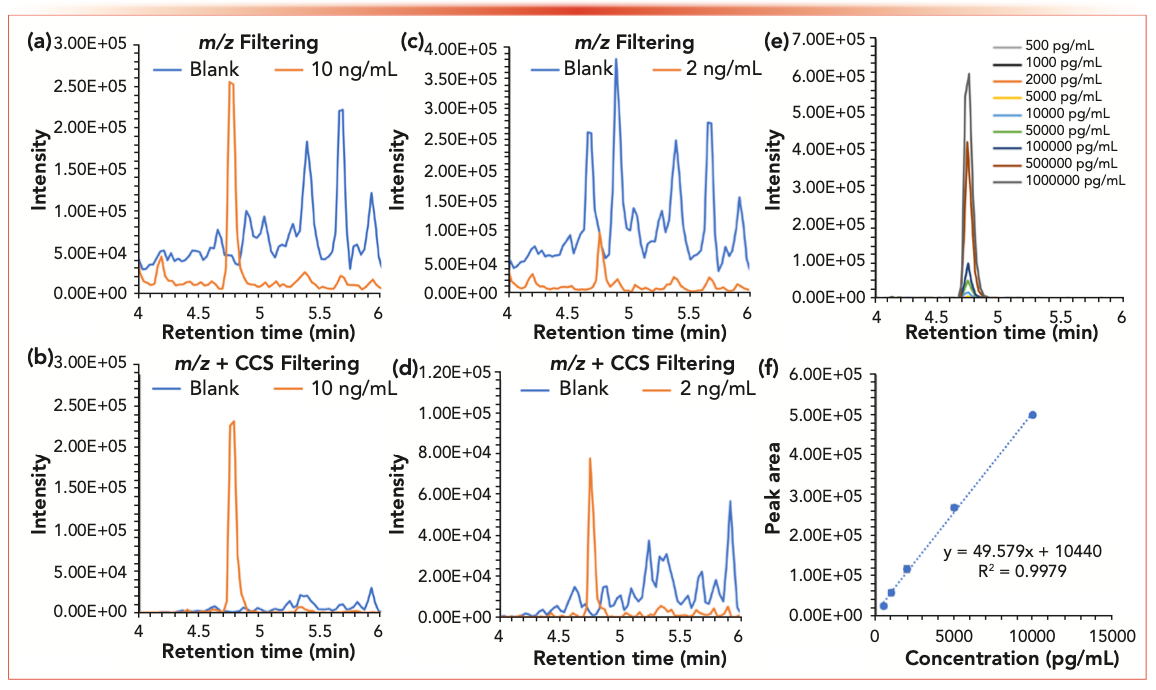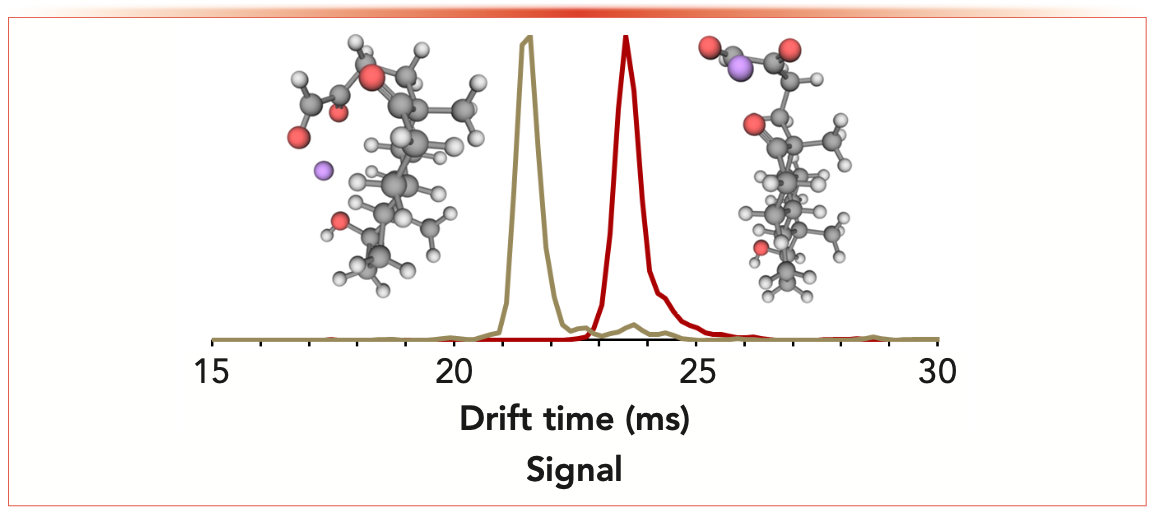Enhancing the Performance of Analytical Methods to Combat Doping in Sport
Ion mobility–mass spectrometry (IM–MS) has become a cornerstone bioanalytical technique over the last two decades. Major advances have included new technology and software that enabled higher resolving power measurements; however, chemistry-based approaches, such as derivatization reactions, have also shown tremendous promise. This article demonstrates our work using IM–MS to detect anabolic steroids and describes how this technology could one day find its way into the anti-doping world.
The world of analytical testing for doping violations in sports and athletic competitions has been dominated by mass spectrometry (MS)-based methods for several decades now, dating back to the development of the University of California, Los Angeles (UCLA) Olympic Analytical Laboratory in 1982. The laboratory was founded in advance of the 1984 Olympic Games in Los Angeles, and it is currently one of only two World Anti-Doping Agency (WADA)–accredited laboratories in the United States (the second being the Sports Medicine Research and Testing Laboratory in Salt Lake City, Utah). There are approximately 30 WADA-accredited laboratories worldwide that oversee the testing of athlete samples, according to the World Anti-Doping Code and the annual Prohibited List.
Many of the methods that are used to enforce the World Anti-Doping Code involve a combination of MS and chromatographic separations (gas or liquid chromatography). The most frequently used MS platform for targeted analysis remains the triple-quadrupole mass spectrometer (QqQ, also notated as TQMS or MS/MS), which has been lauded for decades because of its superior sensitivity when operated with selected reaction monitoring (SRM). More recently, high-resolution platforms have become more routine in analytical laboratories because their ability to determine molecular formulae from accurate mass measurements has been joined by improved quantitative capabilities. Despite widespread implementation of modern MS instrumentation and advanced software for data interpretation, much active research focuses on qualitative and quantitative improvements. One such advance has been the commercialization of ion mobility (IM)–MS instrumentation.
Ion mobility spectrometry (IMS) is a gas-phase separation technique first developed in the 1950s for defense applications, including the detection of chemical warfare agents. IMS technology has also been heavily utilized in airport security checkpoints as a rapid screening tool; in fact, tens of thousands of these standalone IMS devices remain in service by government and military entities across the United States. However, the IM–MS technique opened a door to the larger and more complex analytes required in bioanalysis, with groups such as those of David Clemmer at Indiana University, Herbert Hill at Washington State University, and Michael Bowers at University of California, Santa Barbara developing early home-built systems to measure carbohydrates, peptides, and proteins, among other biomolecules.
IMS shares some similarities with MS in that it uses electric fields to manipulate ions for measurement. Unlike MS, which is performed under a high vacuum to increase the mean free path (that is, avoiding collisions between analyte ions and stray gas molecules), IMS operates at pressures as high as 1 atm. This pressure results in many collisions so that analyte ions are separated by mass and by a combination of size, shape, and charge. Historically, IMS has seen applications ranging from the study of native protein structure (misfolding in neurodegenerative diseases) to the separation of small molecule isomers, which may look identical even with today’s highest-resolution mass spectrometers.
In the last 20 years, almost all major MS vendors have released their own version of IM–MS platforms, dating back to Waters Corporation’s release of the Synapt HDMS in 2006. Furthermore, several other companies have also introduced their own “add-ons” that can easily be coupled to existing MS instruments. Such widespread adoption of IM–MS technology has moved this technology past the “emerging” stage and becoming a cornerstone of bioanalytical laboratories.
The Future of Ion Mobility in Anti-Doping?
Despite the widespread adoption of IM–MS technology, routine implementation of IM–MS instrumentation in regulated analyses, such as those performed in clinical testing or anti-doping laboratories, has not happened yet. The basic science performed in our group is largely focused on the application of IM–MS to steroids and related metabolites, with previous studies highlighting its use for analyzing anabolic steroids, bile acids, and vitamin D metabolites, to name a few. As an example, our group has demonstrated improved quantification of target analytes, such as testosterone in human urine (Figure 1) (1). More recently, we started investigating ways in which we can improve the performance of modern instrumentation for applications, including anti-doping.
FIGURE 1: Quantitative analysis of testosterone (as [M + Na]+) extracted from human urine using both (a) m/z filtering only and (b) m/z + CCS filtering at 10 ng/mL; and at (c–d) 2 ng/mL, demonstrating significantly reduced blank baseline with mobility filtering. Quantitation was possible (e) over several orders of range, and (f) was linear in the low concentration range, with a limit of detection of 524 pg/mL (1).

Early work goes back almost a decade to the first simple IM–MS analysis of steroid isomers. Given their identical exact mass (and oftentimes very similar MS/MS fragmentation patterns), these were ideal targets for mobility separations. The early studies laid the groundwork and demonstrated the potential for IM–MS by separating a series of endogenous steroid isomers (2). However, challenges emerged, including the resolution of stereoisomers such as the epimers testosterone and epitestosterone. Differentiation could be achieved when measuring these species as dimers because of different stacking structures, but these were only observed at high concentrations and were unlikely to be feasible in realistic samples (2,3).
It was during this time that computational modeling was also starting to be seen as a critical complement to experimental IM–MS studies. By using density functional theory, our collaborators could determine the gas-phase structures (with a high degree of accuracy) that accounted for the empirical results we produced. Such studies allowed us to determine the stacking structure of steroid multimers, as well as conformational differences for clinically relevant 25-hydroxyvitamin D3 isomers (3–5). These complementary studies have become routinely incorporated into IM–MS research.
Despite some of the early promise demonstrated, it was clear that the limited resolving power of many of the early IMS instruments would be restrictive for separating structurally similar species such as stereoisomers. In fact, the last decade has seen a collective push toward advancing higher-resolution IMS hardware and software. As an example, researchers at the Pacific Northwest National Laboratory (PNNL) have developed a new IM platform that has enabled serpentine long-path separations and has even been applied to the steroid subclass of bile acids (6). The technology has since been commercialized by Mobilion Systems.
Aside from hardware and software advances, others in the field have focused on using chemistry to modify molecular structure and augment separation capabilities. The inspiration for the work done today dates back to early studies from the groups of Colin Creaser (then at Nottingham Trent University), David Clemmer at Indiana University, and John McLean at Vanderbilt University. Our group has seized upon this inspiration to apply these strategies to the study of steroids, focusing on modifications of alkene, hydroxyl, and carbonyl chemistry. Our most recent work has borrowed from the lipidomics field and specifically ozonolysis and Paternò-Büchi reactions. With ozonolysis, we exposed steroids to ozone, which resulted in cleavage of the C=C double bonds and an opening of the A-ring in isomers testosterone and epitestosterone (Figure 2). The structural flexibility introduced by this cleavage resulted in unique gas-phase structures that could easily be resolved (when the unre- acted isomers were nearly identical). Again, computational modeling results confirmed our experimental studies and demonstrated the differences in the points of interaction with a sodium ion between the ozonolysis products of testosterone and epitestosterone (7). As a follow-up study, we applied UV radiation in the presence of acetone to perform the Paternò-Büchi reaction, which involves radical addition of a carbonyl across a C=C double bond. This was used to modify a series of endogenous steroid isomers, which resulted in unique fingerprint spectra that allowed differentiation (8).
FIGURE 2: Ion mobility separation of the ozonolysis products of testosterone and epitestosterone and their corresponding structures (7).

Conclusion
Although IM–MS has yet to become the gold standard in regulated bioanalysis methods (that is, clinical and anti-doping), the technology has shown tremendous promise. It is clear from the trajectory of current research that advances in hardware, software, and chemistry-based approaches to separations will pave the way for its even more widespread implementation.
References
(1) D.C. Velosa, M.E. Rivera, S.P Neal, S.S.H. Olsen, A. Burkus-Matesevac, and C.D. Chouinard, J. Am. Soc. Mass Spectrom. 33(1), 54–61 (2022). DOI: 10.1021/jasms.1c00231
(2) C.D. Chouinard, C.R. Beekman, H.M. King, R.H.J. Kemperman, and R.A. Yost, Int. J. Ion Mobil. Spectrom. 20, 31–39 (2017). DOI: 10.1007/s12127-016-0213-4
(3) C.D. Chouinard, V.W.D. Cruzeiro, A.E. Roitberg, and R.A. Yost, J. Am. Soc. Mass Spectrom. 28, 323–331 (2017). DOI: 10.1007/s13361-016-1525-7
(4) C.D. Chouinard, V.W.D. Cruzeiro, C.R. Beekman, A.E. Roitberg, and R.A. Yost, J. Am. Soc. Mass Spectrom. 28(8), 1497–1505 (2017). DOI: 10.1007/s13361-017-1673-4
(5) C.D. Chouinard, V.W.D. Cruzeiro, R.H.J. Kemperman, N.R. Oranzi, A.E. Roitberg, and R.A. Yost, Int. J. Mass Spectrom. 432, 1–8 (2018). DOI: 10.1016/j.ijms.2018.05.013
(6) C.D. Chouinard, G. Nagy, I.K. Webb, S.V.B. Garimella, E.S. Baker, Y.M. Ibrahim, and R.D. Smith, Anal. Chem. 90(18), 11086–11091 (2018). DOI: 10.1021/acs.analchem.8b02990
(7) S.W. Maddox, R.H. Fraser Caris, K.L. Baker, A. Burkus-Matesevac, R. Peverati, and C.D. Chouinard, J. Am. Soc. Mass Spectrom. 31(2), 411–417 (2020). DOI: 10.1021/jasms.9b00058
(8) S.W. Maddox, S.S.H. Olsen, D.C. Velosa, A. Burkus-Matesevac, R. Peverati, and C.D. Chouinard, J. Am. Soc. Mass Spectrom. 31(10), 2086–2092 (2020). DOI: 10.1021/jasms.0c00215
Christopher D. Chouinard is an Assistant Professor of Chemistry at the Florida Institute of Technology, in Melbourne, Florida. Direct correspondence to: cchouinard@fit.edu
Study Explores Thin-Film Extraction of Biogenic Amines via HPLC-MS/MS
March 27th 2025Scientists from Tabriz University and the University of Tabriz explored cellulose acetate-UiO-66-COOH as an affordable coating sorbent for thin film extraction of biogenic amines from cheese and alcohol-free beverages using HPLC-MS/MS.
Quantifying Microplastics in Meconium Samples Using Pyrolysis–GC-MS
March 26th 2025Using pyrolysis-gas chromatography and mass spectrometry, scientists from Fudan University and the Putuo District Center for Disease Control and Prevention detected and quantified microplastics in newborn stool samples.
Multi-Step Preparative LC–MS Workflow for Peptide Purification
March 21st 2025This article introduces a multi-step preparative purification workflow for synthetic peptides using liquid chromatography–mass spectrometry (LC–MS). The process involves optimizing separation conditions, scaling-up, fractionating, and confirming purity and recovery, using a single LC–MS system. High purity and recovery rates for synthetic peptides such as parathormone (PTH) are achieved. The method allows efficient purification and accurate confirmation of peptide synthesis and is suitable for handling complex preparative purification tasks.












